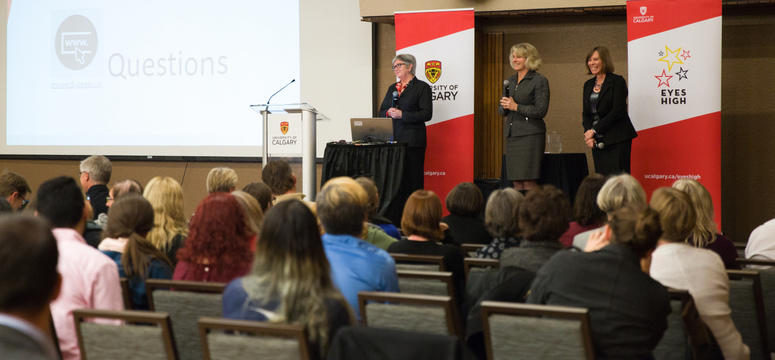
Provost Dru Marshall, and VP (Finance and Services), President Elizabeth Cannon, and Linda Dalgetty.
Riley Brandt, University of Calgary
Nov. 20, 2015

Provost Dru Marshall, and VP (Finance and Services), President Elizabeth Cannon, and Linda Dalgetty.
Riley Brandt, University of Calgary
Students, faculty and staff had the opportunity to learn more about the university’s finances at the Budget Town Hall held Nov. 18 at the university. President Elizabeth Cannon, Provost and Vice-President (Academic) Dru Marshall and Vice-President (Finance and Services) Linda Dalgetty discussed the current financial position, the 2016-17 budget process, as well as the opportunities and challenges ahead.
Marshall provided an update on provincial government funding and what has changed since last spring. The previous government had reduced the provincial grant by 1.4 per cent and reduced target enrolment funding to the university. When the new provincial government came to power in the summer, a mini provincial budget tabled on June 14, restored the 1.4 per cent in funding and provided a two per cent ($8.4 million) cost of living allowance. The government also froze tuition for two years at 2014-15 levels, repealed market modifiers but provided backfill funding for 2015-16 for both. The government also restored target enrolment funding. The provincial government budget tabled Oct. 27 in the legislature reaffirmed the Government of Alberta’s commitment to post-secondary education.
Since university budget planning had been based on the previous government’s budget, the university had reduced spending two per cent ($8.4 million). Along with $200,000 from operating contingency, this allowed $17 million in available funding to be spent in needed areas. The first priority was to cover salary settlements totaling $13.9 million, with the remainder going to facilities, Desire2Learn and academic portfolio in priority areas.
Dalgetty then reported on unrestricted net assets (UNA), which is essentially a rainy day fund available for unforeseen expenditures. Based on a target of five per cent of the university’s consolidated budget, the university’s UNA was $56 million on March 31, 2015. After careful study it was determined that it was more appropriate to set the target UNA at five per cent of the operating budget ($40 million). As a result, the university had $16 million freed up for a number of one-time strategic initiatives such as classroom and facility upgrades (CAR/FAR ), campus wayfinding, and IT stabilization.
While the university has been able to balance its budget through sound financial planning, it simply isn’t sustainable in the long run. The university continues to advocate for stable and predictable government funding. When funding is inconsistent, consistent planning is difficult. While the recent increase from the new government is welcome, the university is still not at the funding level it was in 2012-13. The Campus Alberta grant now makes up only one-third of the total $1.27 billion consolidated budget each year. Tuition also continues to drop as a percentage of total revenue each year. While tuition has been frozen for the next two years, the government has only committed backfill funding for 2015-16 but has made no commitment for 2016-17. This means the university could lose $3.7 million in funding. The gap between Alberta average tuition and the Canadian average will continue to grow.
Another challenge facing the university is salary and benefit costs which make up 58 per cent of total expenses. Dalgetty reported that total salary expenditures have increased 25 per cent over the last five years or $146.8 million in total.
“Salaries and benefits rise four to five per cent each year, while the Campus Alberta cost of living increase from government is two per cent,” says Dalgetty. “The two to three per cent gap compounds over time. Salary and benefit costs are also impacted by increased staff numbers."
Marshall then illustrated what the growing gap between revenue growth and expenditure growth means for the university.
“Our revenue growth is expected to be $8.4 million in 2016-17 with the two per cent promised increase in provincial funding,” says Marshall. “However, our expected expenditure growth will be at least $28.4 million in 2016-17 due to inflationary costs across supplies and services, and salary and benefit costs.”
This leaves a gap of $20 million. As a result, in the university’s planning parameters for the budget year 2016-17 a one to 1.5 per cent reduction in expenditures is proposed.
“We will be able to manage this in the short term given the sound financial health of our institution, ”Marshall said. “But we simply must continue to advocate for stable and predictable government funding. We look forward to fully participating in the government review of the provincial funding model.”
The budget town hall presentation is available on the provost website.